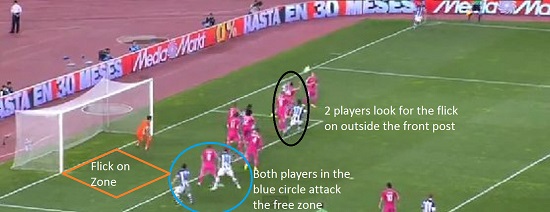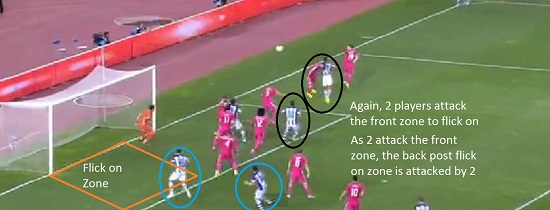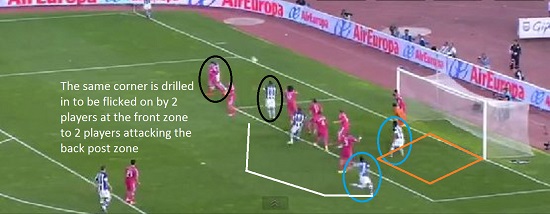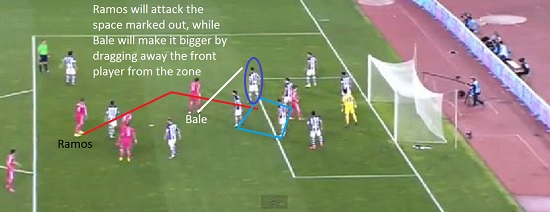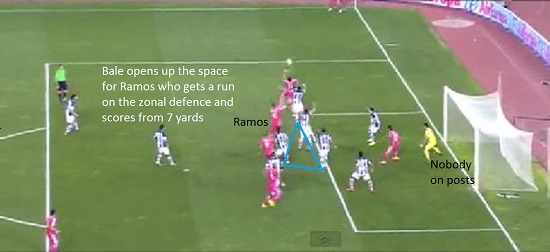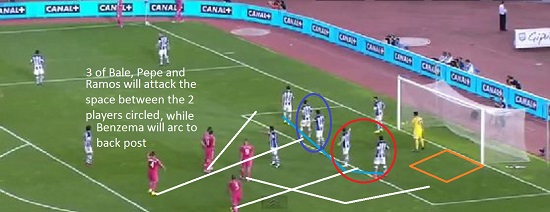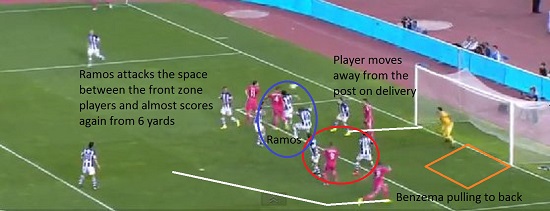By Stevie Grieve
In the recent match between Real Sociedad and Real Madrid, there were 6 goals, with 50% scored from corner kicks, with several other missed headers and 2nd balls which could’ve resulted in more goals.
Interestingly, both teams chose to leave the back post open with no player on there, which turned out to be a zone which was tried to be exploited by both teams.
Sociedad Corner Routine
- 6 players forward, GK and 3 back, 1 at 35m
- Drilled, flat delivery to around 6m
- 2 men at the front zone for the flick on
- 2 men attack the back – 1 from a central starting position who loops around unmarked
- 1 player on edge of the box for rebounds
Near Post Flick on routine
As the flat ball is drilled in, it has enough pace that a flick on will continue fast enough past the GK and central defensive players. Sociedad look to exploit the back post zone as there is nobody on the post to come off the post and cover any flick ons, so having 2 players here increases their chances.
Real Madrid set up with Kroos trying to block the low ball into the front zone, with 3 man-markers and 4 players across the 6m line, and 1v1 on the 18m line but little protection beyond the far post.
As the ball is flicked on, it is too high to catch, and follows into the flick on zone, which results in a tap in from inside 3m. If the scorer had stood inside the zone, he could’ve been offside.
Vela in the poacher position due to the player on the front post playing everyone onside
Sociedad use the same routine – drilled ball at head height to the front zone, with a player arcing to the back post. Interestingly, as Real Madrid now have a player on the front post, this allows Vela to drift into the back post zone and stay onside from any flick on, which he scores from.
Ramos goal – Front post zone with Bale creating space
Similar to Real Sociedad, Real Madrid have 2 players attack the front zone – Bale to create space for Ramos who attacks the zone between the 4 players in the diamond. Benzema will arc to the back post while Pepe attacks the space inside the back post at 6m.
Sociedad set up with 5 players staggered across the 6m line but not really in a cohesive shape to defend and inswing corner, with 1 player covering between the post and 6m.
The distance that Ramos and Pepe run from, will give them a huge power advantage when they go to meet the ball in the air, while Bale is explosive enough to accelerate and jump wth a 5m run to the zone he will attack.
Ramos wins the header easily as Bale drags away the marker. The body shape of the Sociedad defenders doesn’t allow them to match the running jump that the attackers have advantage of due to the deep position and distance of the run, giving Ramos enough pace to out-jump everyone.
As there is nobody on the back post, Sociedad have nobody to clear off the line with the GK too close to the front post. Madrid have James in a deep position diagonal from the corner incase the ball is flicked out and away from goal.
Ramos 2nd chance
Similar to the goal, Bale, Pepe and Ramos make the same runs, but Sociedad have adjusted the way they set up, now with 5 players across the 6m line, with a player covering the front zone who will protect the post and come out to win anything between 6m and goal line.
Similar to the goal scored by Ramos previously, he gets a clear run and jump on his opponent and narrowly misses to the far post. Sociedad have nobody with the correct starting body position to challenge, while the run between 2 players results in confusion as to who takes responsibility for the marking.
For teams playing against Real Madrid, Ramos loves to attack the space front zone space and heading to the back post (ie Champions League final) , so to prevent scoring opportunities Ramos needs to be tracked and blocked from getting within 8m of goal, while keeping a player in position to clear anything towards the back post.
For Real Madrid, the warning signs existed from the 1st corner, they should’ve adapted to ensure coverage of the back post zone where the 2nd ball was the target for Sociedad.
By Stevie Grieve. (Follow on Twitter @steviegrieve) Stevie is also the author Coaching the 4-2-3-1, Coaching the 4-2-3-1 Advanced Tactics and From Futsal to Soccer

